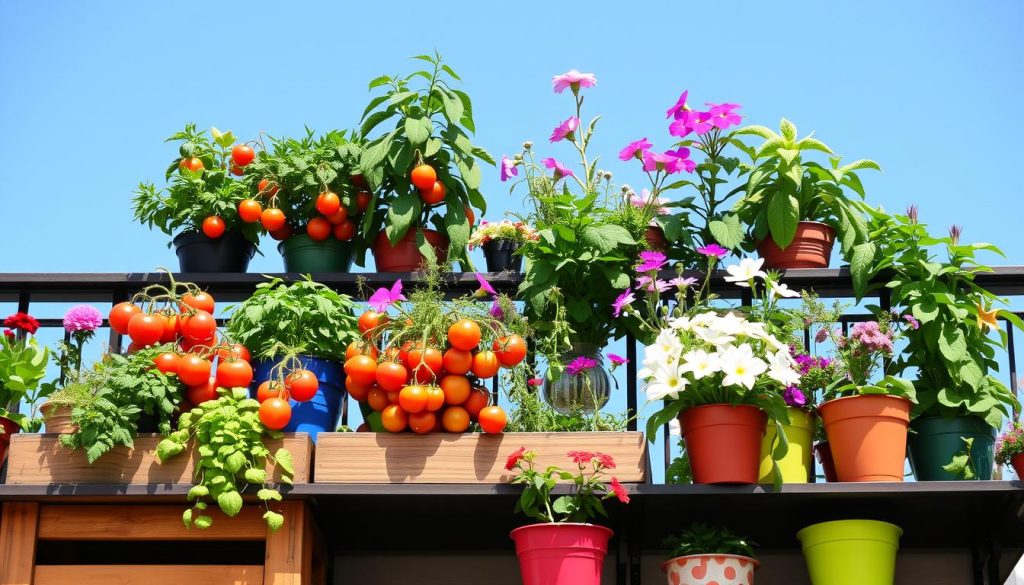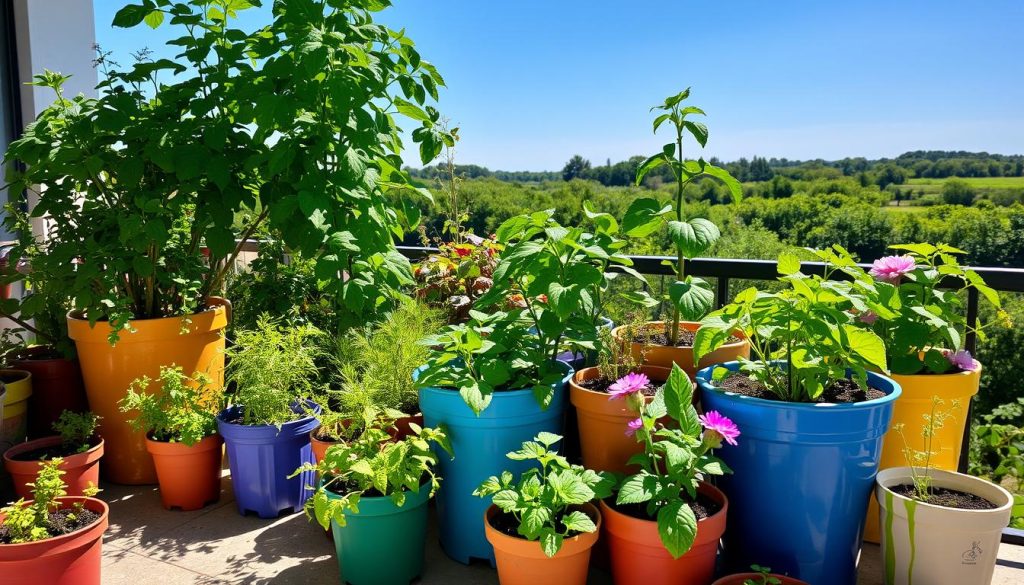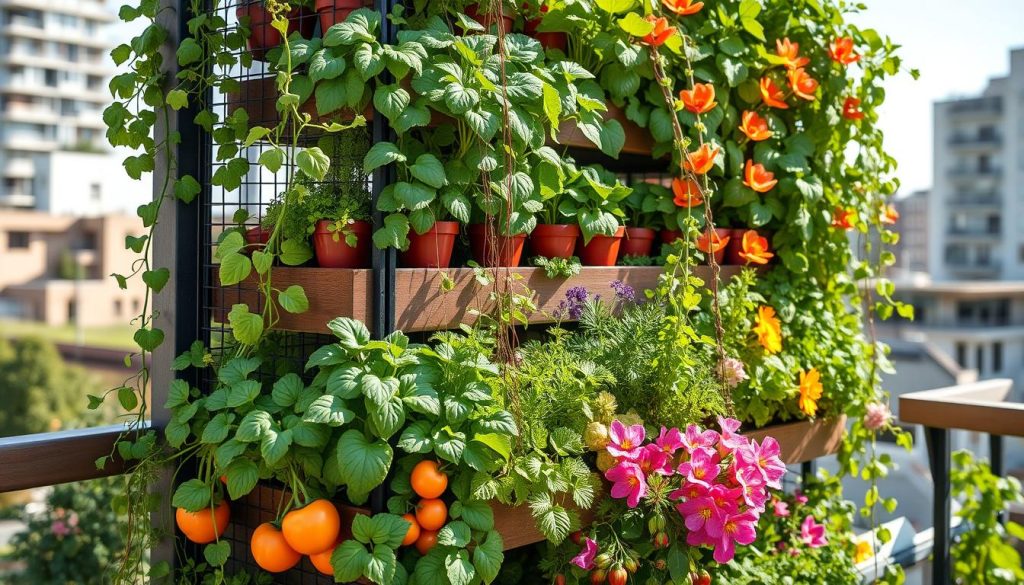Container gardening is a great way for city folks, apartment dwellers, and those with little outdoor space to grow their own food. You can use pots, buckets, or raised planters to grow herbs, veggies, and some fruits. This lets you enjoy fresh produce right in your backyard, patio, or balcony.
If you have a small yard, bad soil, or want easy access to homegrown food, container gardening is for you. It lets you enjoy the benefits of gardening, even in tight spaces.

Key Takeaways
- Container gardening lets you grow fresh food in small spaces, perfect for city folks and beginners.
- It uses pots, buckets, or raised benches to grow herbs and veggies.
- Container gardens can go on balconies, patios, or decks, making fresh food easy to get for many people.
- This method is great for those with small yards, bad soil, or little outdoor space.
- Container gardening lets you pick what to grow in any space, from tiny apartments to big houses.
Getting Started with Container Gardening
Container gardening is great for any space, whether it’s a patio, balcony, or apartment. You’ll need a few things to start: containers with holes, good potting soil, seeds or seedlings, and water. You can even use items like yogurt containers or plastic buckets, just make sure to drill holes in the bottom.
Understanding Basic Requirements
To grow plants well in containers, know what they need. Big plants like tomatoes and peppers do best in 5-gallon containers. Smaller plants like leafy greens and herbs need only 1-gallon pots. It’s important to have containers with holes to avoid waterlogged soil.
Use potting soil, not garden soil, for the best results. It’s packed with nutrients that plants love.
Choosing Your Growing Space
- Find a spot that gets at least 6 hours of sunlight a day. Most plants need lots of light to grow well.
- Think about how easy it is to get to your plants, the temperature, and if they’re protected from wind or harsh weather.
- Move your containers to warmer spots if it gets too cold. Also, keep them away from direct sunlight during the hottest part of the day to prevent the soil from drying out too fast.
With the right containers, soil, and a good spot, you’re ready to start growing. Learn what your plants need, and soon you’ll be enjoying fresh produce from your own garden.
Benefits of Growing Food in Containers
Urban gardening and small-space gardening are gaining popularity. Container gardening offers many benefits for those with little outdoor space. It lets you control the growing environment and move plants easily. This makes it perfect for growing fresh, healthy food right at your doorstep.
Container gardening lets you grow many edible plants, even in small spaces. Studies show that plants like tomatoes, peppers, and dwarf citrus trees do well in pots. This means people in apartments, condos, or small yards can grow their own food without a big garden.
Container gardening also gives you control over the growing environment. You can use the right soil, water, and pest control. This is great for those with mobility issues, making gardening easier and more accessible.
- Grow fresh, healthy food in limited spaces
- Enjoy the flexibility to move plants as needed
- Customize the growing environment for optimal results
- Enhance the aesthetic appeal of outdoor spaces
Container gardening can also make your outdoor spaces look better. By placing containers well, you can make your balcony, patio, or small area look vibrant and productive. This blends beauty and function perfectly.
Container gardening is great for both new and experienced gardeners. It lets you grow your own food, even in the city. By using small-space gardening, you can enjoy fresh flavors, sustainability, and satisfaction from your own home.
Selecting the Right Containers and Materials
Choosing the right containers and materials is key for successful container gardening. The size, drainage, and material of your containers affect plant growth and health. It’s important to pick the right size and drainage for your plants, whether they’re herbs, vegetables, or flowers.
Container Size Guidelines
The size of your container should match the mature size of your plants. A 24-inch diameter pot is good for large pepper plants and indeterminate tomatoes. It’s also great for cucumbers, artichokes, and mixes of vegetables and herbs.
An 18-inch diameter pot is best for broccoli, cauliflower, and small eggplants. It’s also good for determinate tomatoes with support. For herbs, cabbage, and spinach, a 14-inch diameter pot is ideal. A 10-inch diameter pot is perfect for small herbs and strawberries.
Drainage Considerations
Drainage is crucial for container gardening. Make sure your containers have enough drainage holes or a gravel layer at the bottom. This lets excess water out.
Porous containers like unglazed terra cotta need more water. Glazed, plastic, or metal containers hold moisture better.
Material Types and Their Benefits
The material of your containers affects plant growth and care. Terracotta clay pots are durable but heavy and dry out fast. Glazed ceramic pots are winter-hardy and colorful but pricey.
Plastic containers are light, durable, and affordable. Wooden containers and half barrels look natural but can be hard to move. Concrete pots are very durable but heavy and permanent.
Soil Mixtures and Growing Medium
Starting a thriving container garden begins with the right soil mix. You need a blend that drains well, holds nutrients, and allows for air. A good mix includes potting soil, compost, peat moss, and perlite.
To create your own soil mix, mix equal parts of these:
- Potting soil
- Compost
- Peat moss
- Perlite
This mix balances moisture, nutrients, and drainage well for container gardens. Don’t use garden soil, as it may not have enough nutrients and can bring pests or diseases.
Most vegetables like a slightly acidic soil pH of 5.5 to 7.0. Adding a handful of organic fertilizer like Plant-tone can boost your soil’s nutrient levels. This helps your plants grow strong in your container garden.
The quality of your soil mix greatly affects your container garden’s success. By making a customized, nutrient-rich mix, you’ll help your plants thrive. This is true whether you garden in the city or a small backyard.
Best Plants for Container Gardens
Gardeners with small spaces can still grow their own food in containers. Many vegetables and herbs do well in pots. Here are some top picks for your container garden:
Vegetables That Thrive in Containers
- Tomatoes
- Peppers
- Eggplants
- Cucumbers
- Radishes
- Potatoes
- Carrots
- Green beans
- Peas
- Lettuce greens
Herbs for Container Growing
- Basil
- Parsley
- Mint
- Rosemary
Companion Planting Options
Adding companion plants to your container garden can boost its health and productivity. Flowers like zinnias and echinacea attract good bugs and look great. Using vertical gardening techniques can also save space.
Light Requirements and Positioning
Getting the right light is key for your container garden’s success, indoors or outdoors. Most veggies and herbs love full sun, needing 6-8 hours of direct sunlight. But, some leafy greens and plants that prefer shade can handle 3-6 hours of sun. When placing your containers, think about how the sun changes throughout the day and seasons. This ensures your plants get the best light.
For indoor gardens, use LED grow lights to make up for natural light. These lights give plants the spectrum they need to grow well. They make sure your indoor plants get the right amount and type of light.
- Full sun plants: Require 6-8 hours of direct sunlight daily
- Partial sun/partial shade plants: Need 3-6 hours of sun exposure
- Shade-loving plants: Prefer less than 3 hours of sun per day

By thinking about your plants’ light needs and where to put your containers, you can make a great container garden. Indoors or outdoors, the right amount of sun is crucial for healthy plants and lots of harvests.
Watering Techniques and Management
Proper watering is key to a thriving container garden. Whether you’re growing urban veggies or colorful flowers, knowing the right watering techniques is crucial. It affects your plants’ health and productivity.
Irrigation Systems
Using an irrigation system can help keep your garden consistently moist. Drip irrigation or self-watering containers offer a steady water supply. This reduces the need for manual watering and prevents over or underwatering.
Moisture Monitoring
Checking soil moisture regularly is vital. The top inch of soil should feel dry before you water again. Container size, plant type, and weather conditions affect how often you need to water.
Common Watering Mistakes
- Overwatering can cause root rot and other problems, so avoid waterlogged soil.
- Underwatering can make plants wilt, stunt their growth, and even kill them.
- Watering during the hottest part of the day can cause too much evaporation. It’s better to water in the morning or evening.
Understanding your container garden’s unique watering needs is important. This ensures your plants get the right moisture at the right time. It sets them up for success.
Fertilizing and Nutrient Management
Keeping the right nutrient levels is key for your container garden’s health and growth. Since container plants have less soil, they need regular fertilizing. It’s important to find the right balance to avoid too much growth that doesn’t produce fruit or veggies.
For fertilizing, choose a balanced, water-soluble fertilizer. Use it every 2 to 4 weeks when plants are growing. You can also mix slow-release fertilizers into the soil for ongoing nutrient supply.
Watch your plants closely and adjust fertilizing as needed. Some plants like tomatoes and cucumbers need more food. But herbs and leafy greens might do well with less.
Success in container gardening comes from finding the right balance. Follow the fertilizer instructions and watch for signs of too much fertilizer. With proper care, your garden will grow well, giving you plenty of fresh produce.
Space-Saving Vertical Gardening Methods
Vertical gardening is a smart way to use space when it’s tight. It lets you grow lots of plants, like veggies and herbs, in a small area. Check out these cool vertical gardening systems to make your small garden look great.
Vertical Growing Systems
Trellises, hanging baskets, wall-mounted planters, and stacked containers are great for vertical gardening. Trellises help plants like cucumbers and peas grow up, saving space. You can hang baskets or planters on walls to add more layers to your garden. Stackable systems let you fit many plants in a small area.
Maximizing Limited Space
- Use tiered plant stands or old shoe organizers for vertical herb gardens.
- Grow tomatoes and beans on trellises or cages to save ground space.
- Tower gardens have many tiers for growing different plants in a small area.
- Living walls let you grow plants right on a wall, making your space look and work better.
Vertical gardening not only saves space but also makes your garden look better. By using these creative methods, you can create a lush vertical garden, even in tiny spaces.

Pest Control and Disease Prevention
As an urban gardener, keeping your container garden healthy is crucial. Watch your plants closely to spot and fix problems early. Use a mix of prevention and organic pest control to make your garden thrive.
Integrated Pest Management (IPM) is a great way to fight pests. It uses a mix of methods to keep your garden safe. This includes cultural, mechanical, and biological controls for insects, weeds, and diseases.
- Keep your garden clean and well-ventilated to keep pests away.
- Use physical barriers like row covers or insect netting to block pests.
- Bring in beneficial insects like ladybugs or lacewings to eat pests.
- Try organic pest control products like neem oil or insecticidal soaps if needed.
It’s also important to watch for plant diseases. Remove any sick parts quickly to stop the disease from spreading. Rotate your crops every year to avoid soil-borne diseases. With the right steps, your container garden can be pest and disease-free.
Seasonal Care and Maintenance
Container gardening changes with the seasons. To keep your plants happy, adapt your care to each season. This is true for veggies, herbs, or flowers.
Spring Preparation
Spring brings warmer weather. It’s time to prep your garden. Clean your containers and refresh the soil. Plant warm-season crops like tomatoes and squash.
Summer Care Tips
Summer is hot and dry. Your plants need more water and food. Water them often and fertilize regularly for growth.
Fall and Winter Management
Fall brings cooler weather. Switch to cool-season crops like kale. For winter, move some plants indoors or use cold frames. Insulate outdoor containers to protect roots.
With proper care, your container garden can thrive all year. It will be a beautiful and productive space. Enjoy it for seasons to come.
Harvesting and Storage Tips
Enjoying what you grow is the best part of container gardening. Knowing when and how to pick your produce is key. It boosts flavor and nutrition. Whether it’s tomatoes, herbs, or greens, these tips will help you enjoy your garden more.
First, pick your produce when it’s at its best. Leafy greens should be picked often to keep growing. Tomatoes, peppers, and eggplants should be picked when they’re the right size and color.
- Keep your picked produce fresh by storing it right. Greens and herbs go in the fridge. Tomatoes and peppers can stay out.
- Try canning, freezing, or drying to enjoy your garden’s bounty all year.
- Regular picking keeps your plants healthy and productive.
By following these container gardening and urban gardening tips, you can enjoy your homegrown food all year. Savor the taste of summer any time.
Sustainable Practices in Container Gardens
Urban gardeners have a chance to use eco-friendly ways in their container gardens. These practices help us grow our own food and herbs while being kind to the planet.
Collecting rainwater is key to sustainable gardening. A simple system can save a lot of water. Also, turning kitchen scraps into compost is great for your soil and cuts down on waste.
- Use organic fertilizers and natural pest control to avoid harsh chemicals and protect nature.
- Choose containers like upcycled buckets or terracotta pots to save money and reduce waste.
- Grow native plants, as they need less water and care for your local area.
By using these green practices, your container garden can become a lush, eco-friendly spot. It will give you fresh food and help the city environment too.
Every small step towards being green in your garden counts. Join online gardening groups, learn about your local weather, and find new eco-friendly ideas for your garden.
Conclusion
Container gardening is a great way to grow food in many places. It works well on small balconies, big patios, or even indoors. You can enjoy growing your own food and feel connected to nature.
Container gardening is very flexible. It lets people with little space grow the plants they want. You can control the soil, water, and sunlight to keep pests away. This makes growing plants easier and more successful.
When starting your container garden, think about a few key things. Choose the right container size, make sure it drains well, and pick good soil. Also, know how to water and fertilize your plants. By doing these things, you can make a green and productive space right where you live.